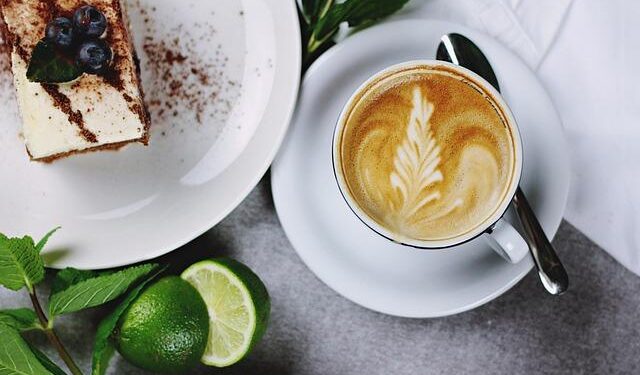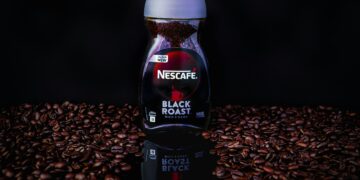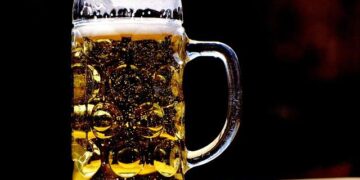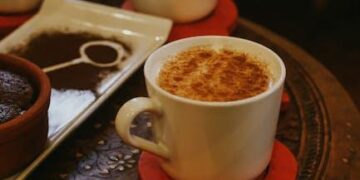Table of Contents
Definitive Caffeine Analysis: Starbucks Iced Coffee Blonde Roast
An inquiry into the caffeine content of a “Starbucks Iced Coffee Blonde Roast” reveals a critical distinction that directly impacts the consumer experience: the name refers to two distinct products with vastly different caffeine profiles.
One is a ready-to-drink (RTD) beverage sold in retail stores, and the other is a beverage prepared by baristas in Starbucks locations.
Understanding the difference between these two formats is paramount.
Executive Summary: A Tale of Two Coffees
The primary finding of this analysis is the significant caffeine discrepancy between the retail and in-store versions of the product.
- Retail Ready-to-Drink (RTD) Bottle: The multi-serving 48 fl oz bottle of Starbucks® Unsweetened Blonde Roast Iced Coffee, manufactured and distributed in partnership with PepsiCo, contains 120 mg of caffeine per 12 fl oz serving.1 This figure is officially stated on the product’s nutritional information and is consistent across this product line.
- In-Store Prepared Beverage: A Starbucks® Iced Coffee prepared with Blonde Roast coffee is a brewed beverage made to order. The base for this drink is the hot-brewed Starbucks® Blonde Roast, which contains approximately 360 mg of caffeine in a Grande (16 fl oz) serving.2 While chilling this coffee over ice introduces some dilution, the foundational caffeine amount is derived from this highly caffeinated brew.
The in-store prepared version contains approximately three times more caffeine than the bottled retail version for a comparable volume.
This substantial difference is not a random variation but a result of distinct product strategies, formulations, and target markets.
Table 1: Executive Summary – Caffeine Content of Starbucks Iced Coffee Blonde Roast (Unsweetened)
| Product Format | Serving Size (fl oz) | Caffeine (mg) | Caffeine per fl oz (mg) | Primary Source |
| In-Store Prepared (Brewed Base) | 16 | 360 | 22.5 | Starbucks Official Data 2 |
| Retail Bottle (Ready-to-Drink) | 12 | 120 | 10.0 | PepsiCo Product Facts 1 |
The “Why” Behind the Discrepancy: Product Strategy and Formulation
The vast difference in caffeine content is a deliberate outcome of separate product strategies for different consumption channels.
The bottled RTD product is part of a consumer packaged goods (CPG) portfolio managed by a Starbucks-PepsiCo partnership.1
These products are engineered for mass-market appeal, requiring shelf stability and a predictable, moderate experience suitable for at-home consumption.
A 120 mg caffeine level aligns with a standard, approachable dose, comparable to a typical cup of home-brewed coffee.
Conversely, the barista-prepared beverage is a core component of the “Starbucks Experience.” This channel thrives on customization and caters to a diverse range of consumer preferences, including those of customers who are specifically seeking a high-caffeine option.
The 360 mg caffeine level in the Grande Blonde Roast positions it as a premium, high-potency product within the brewed coffee portfolio.
The different manufacturing processes, target audiences, and corporate oversight result in distinct formulations.
This creates a significant potential for consumer confusion, where an individual accustomed to the 120 mg RTD beverage could unknowingly consume a very high dose of caffeine by ordering the seemingly equivalent drink in-store, potentially exceeding their personal tolerance or the daily recommended limit in a single serving.
The Blonde Roast Anomaly: Why Lighter Roasts Pack a Heavier Punch
A common misconception among coffee drinkers is that the darker and more robust-tasting a coffee is, the more caffeine it contains.
However, data from Starbucks’ own brewed coffee lineup directly contradicts this belief, revealing that caffeine content is inversely correlated with roast intensity.
This phenomenon is best exemplified by the Blonde Roast.
The Conventional Wisdom vs. The Data
For a Grande (16 fl oz) serving of hot brewed coffee at Starbucks, the official caffeine content decreases as the roast becomes darker 2:
- Blonde Roast (Light): 360 mg
- Medium Roast (Pike Place): 310 mg
- Dark Roast: 260 mg
This data clearly establishes that the lightest, most “mellow” roast delivers the highest caffeine dose, an anomaly that is explained by the physics of coffee roasting and brewing measurements.
The Science of Roasting: Mass vs. Volume
The explanation for this counterintuitive fact does not lie in caffeine being “burned off.” Caffeine is a remarkably stable compound at the temperatures used for coffee roasting; any loss due to sublimation is minimal and not the primary driver of the difference.7
Instead, the key lies in the physical transformation of the coffee bean.
As beans are roasted for longer periods, they lose water and other volatile compounds.
This process causes them to lose mass and, critically, decrease in density—they become lighter and slightly larger.2
This change in density creates a crucial distinction depending on how the coffee is measured for brewing:
- Measuring by Weight: If one were to measure 20 grams of Blonde Roast and 20 grams of Dark Roast, the total caffeine would be nearly identical. In fact, the Dark Roast might have a slightly higher percentage of caffeine by weight, as other compounds have been roasted away, concentrating the stable caffeine in the remaining mass.8
- Measuring by Volume: This is the standard practice in most café environments, including Starbucks, where coffee is often measured with scoops. Because Blonde Roast beans are denser, a scoop of ground Blonde Roast contains more coffee mass than the same volume scoop of the lighter, less-dense Dark Roast grounds.2 Therefore, when brewing with a volumetric scoop, one starts with more coffee material—and thus more total caffeine—when using a light roast.
While some baristas have noted that Starbucks uses a slightly smaller scoop for Blonde Roast to partially offset this effect, the official, published caffeine numbers confirm that the final brewed beverage is intentionally formulated to be the most caffeinated option.7
Decoupling Flavor from Function
This “Blonde Roast Anomaly” is not an accident but a sophisticated product strategy.
Starbucks successfully decouples the sensory perception of “strength”—associated with the bold, bitter, and roasty flavors of a dark roast—from the functional delivery of caffeine.
The company markets its Blonde Roast with descriptors like “mellow,” “smooth,” and “subtly sweet,” appealing to consumers who may not enjoy the intensity of darker roasts.3
Simultaneously, this same “easy-drinking” coffee provides the highest caffeine payload in their brewed coffee lineup.4
This allows Starbucks to capture two distinct market segments with a single product line: the flavor-conscious consumer who dislikes bitterness and the function-focused consumer seeking maximum caffeine.
Table 2: Comparative Caffeine Profile of Starbucks Grande (16 fl oz) Brewed Coffees
| Roast Profile | Official Caffeine (mg) | Flavor Profile Keywords | Analyst’s Note on Target Consumer |
| Blonde Roast | 360 | Mellow, smooth, subtly sweet, easy-drinking 12 | Seeks maximum caffeine and/or a less intense, non-bitter flavor. |
| Medium Roast | 310 | Balanced, smooth, rich, notes of cocoa & nuts 4 | The “default” coffee drinker seeking a familiar, well-rounded cup. |
| Dark Roast | 260 | Rich, bold, robust, fuller body 4 | Prefers intense, roasty flavor and associates it with a “strong” coffee experience. |
A Comparative Analysis of the Starbucks Cold Coffee Portfolio
To fully understand the caffeine profile of an Iced Coffee Blonde Roast, it is essential to benchmark it against other popular unsweetened cold coffee options available at Starbucks.
This comparison reveals that specifying “Blonde Roast” for an iced coffee elevates it from a moderate choice to a high-caffeine outlier.
The Standard Cold Coffee Landscape
Starbucks offers three primary platforms for unsweetened, non-blended cold coffee, each with a distinct preparation method and caffeine profile for a Grande (16 fl oz) size:
- Standard Iced Coffee: This beverage is prepared by brewing coffee at double strength (typically using the medium-roast Pike Place) and then chilling it rapidly by pouring it over ice.13 This method results in some dilution from the melting ice. The standard Grande Iced Coffee contains approximately
165 mg of caffeine.4 - Cold Brew: This coffee is made by steeping coarse-ground coffee in cold water for 20 hours. This slow, low-temperature extraction creates a smooth, low-acid coffee concentrate that is then diluted with water or milk before serving.13 A Grande Cold Brew contains
205 mg of caffeine.2 - Iced Caffè Americano: This drink is composed of espresso shots topped with cold water and ice. A Grande Iced Americano is made with three shots of espresso.19 As a standard Starbucks espresso shot contains approximately 75 mg of caffeine, the total is a highly consistent
225 mg of caffeine.2
Inserting the Blonde Roast: Disrupting the Hierarchy
The standard hierarchy of caffeine in these cold drinks is clear: Iced Americano (225 mg) > Cold Brew (205 mg) > Standard Iced Coffee (165 mg).
However, a customer’s request to make the Iced Coffee with Blonde Roast fundamentally alters this landscape.
The brewing process remains the same (hot brew chilled over ice), but the base coffee changes from the Pike Place Roast (310 mg/16 oz) to the much more potent Blonde Roast (360 mg/16 oz).
Even accounting for the dilution from ice, the initial caffeine concentration is significantly higher.
The total caffeine consumed in the final drink is derived from this 360 mg base, placing it at the very top of the caffeine chart for cold coffees, far exceeding the Iced Americano.
Table 3: Comparative Caffeine Profile of Starbucks Grande (16 fl oz) Unsweetened Cold Coffees
| Beverage | Preparation Method | Official Caffeine (mg) | Analyst’s Note on Caffeine Profile |
| Iced Coffee (Blonde Roast) | Hot-brewed Blonde Roast, chilled over ice | 360 (base) | Highest caffeine. The most potent option, derived from the highest-caffeine brewed coffee. |
| Iced Caffè Americano | Espresso shots diluted with water and ice | 225 | High and consistent caffeine, based on a fixed number of espresso shots. |
| Cold Brew | Cold-steeped concentrate, diluted with water | 205 | Higher than standard iced coffee due to concentrate-based brewing, with a smooth, low-acid profile. |
| Iced Coffee (Standard) | Hot-brewed Medium Roast, chilled over ice | 165 | The default, most moderate option in the cold coffee category. |
The Power of Customization and the Knowledge Gap
This analysis highlights a key aspect of the Starbucks service model: customization empowers knowledgeable consumers to “hack” the menu for a desired outcome, while potentially creating unpredictable results for the uninformed.
A customer who orders a default “Iced Coffee” receives a moderate 165 mg of caffeine.
However, a customer armed with the knowledge that “Blonde has more caffeine” can specify “Iced Coffee with Blonde Roast” and receive a beverage with a caffeine base more than double that amount.
This significant difference is not explicitly advertised on menu boards, creating a knowledge gap.
The ability to achieve a specific functional outcome (in this case, maximum caffeine) rests on the consumer’s awareness of the underlying product data.
The Final Cup: How Preparation, Serving Size, and Dilution Affect Caffeine Intake
The official caffeine figures provide a standardized baseline, but the actual amount of caffeine a consumer ingests is modified by final preparation choices, particularly serving size and dilution.
The Impact of Serving Size
Caffeine content at Starbucks scales significantly with serving size.
The jump is particularly pronounced when moving from a Grande to a Venti, which for hot drinks increases from 16 fl oz to 20 fl oz.
- Short (8 oz): Blonde 180 mg, Pike Place 155 mg, Dark 130 mg
- Tall (12 oz): Blonde 270 mg, Pike Place 235 mg, Dark 195 mg
- Grande (16 oz): Blonde 360 mg, Pike Place 310 mg, Dark 260 mg
- Venti (20 oz): Blonde 475 mg, Pike Place 410 mg, Dark 340 mg
This data, sourced from multiple analyses of Starbucks’ offerings, shows that a Venti Blonde Roast contains 475 mg of caffeine.4
This single beverage exceeds the 400 mg daily caffeine limit recommended for healthy adults by health authorities like the U.S. Food and Drug Administration.3
Table 4: Caffeine Content of In-Store Brewed Coffee by Size and Roast (mg)
| Size (Volume) | Blonde Roast (mg) | Medium Roast (Pike Place) (mg) | Dark Roast (mg) |
| Short (8 fl oz) | 180 | 155 | 130 |
| Tall (12 fl oz) | 270 | 235 | 195 |
| Grande (16 fl oz) | 360 | 310 | 260 |
| Venti (20 fl oz) | 475 | 410 | 340 |
The Role of Dilution: Ice, Water, and Formulation
The term “dilution” has different meanings across the cold coffee portfolio:
- The Ice Factor: In a standard Iced Coffee, hot-brewed coffee is poured over ice. This action melts some of the ice, increasing the total liquid volume and reducing the caffeine concentration (mg per fl oz). However, the total amount of caffeine in the cup is determined by the initial volume of coffee concentrate used before the ice was added.22 A consumer who drinks the beverage quickly will ingest the full caffeine load before it has been significantly diluted by melting ice.
- The Water Factor: In an Iced Americano, water is a primary ingredient used to dilute the espresso shots to create a full beverage. The caffeine content is fixed by the number of shots, not by the amount of water or ice added.
- The Formulation Factor: The bottled RTD Iced Coffee is a pre-diluted, homogenized product. The 120 mg per 12 fl oz figure is fixed and highly consistent, as it is the result of a controlled factory manufacturing process, unlike the potential for slight variations in a hand-prepared barista drink.1
The Underlying Science of Caffeine Extraction
The caffeine content in a final cup of coffee is the result of a complex series of variables, beginning with the bean itself and extending through every step of the brewing process.
Starbucks’ ability to deliver consistent caffeine levels is a testament to its mastery over these variables.
Primary Determinants of Caffeine Potential
Before brewing even begins, the potential caffeine content is largely set by two factors:
- Bean Species: This is the most significant factor. The Coffea canephora species, known as Robusta, contains nearly double the caffeine of Coffea arabica.9 Starbucks primarily uses 100% Arabica beans, meaning it starts with a bean that is naturally lower in caffeine. The high caffeine levels in its Blonde Roast are therefore an achievement of process, not a result of using high-caffeine Robusta beans.
- Cultivation and Origin: A bean’s inherent caffeine content is also influenced by its growing conditions. Factors such as altitude (plants at higher altitudes may produce less caffeine as a defense mechanism), soil composition, climate, and post-harvest processing all contribute to the final chemical makeup of the green coffee bean.24
Key Variables in Caffeine Extraction
Transferring the caffeine from the ground bean to the liquid brew is governed by several key principles of chemistry and physics 24:
- Water Temperature: Caffeine’s solubility increases dramatically with temperature. Hot water is a far more efficient and rapid solvent for caffeine than cold water.24 This fundamental principle explains why hot-brewed Iced Coffee and cold-steeped Cold Brew have such different extraction profiles and caffeine levels.
- Brewing Method and Time: While longer contact time generally increases extraction, this is heavily modified by temperature and pressure. The high pressure and temperature of an espresso machine extract caffeine intensely in under a minute, whereas the low temperature of Cold Brew requires 20 hours to achieve its signature concentrate.13
- Grind Size: A finer grind increases the surface area of the coffee particles exposed to water, generally allowing for a faster and more complete extraction of caffeine.9
- Coffee-to-Water Ratio: The ratio of ground coffee to water is a critical lever for controlling the strength and caffeine concentration of the final brew. A higher ratio (more coffee to less water) results in a more concentrated beverage. Starbucks’ use of a “double-strength” brew for its Iced Coffee is a direct application of this principle to ensure the drink is not overly diluted by ice.14
The vast number of variables that can affect a cup of coffee presents a significant challenge for a global chain.
Starbucks mitigates this inherent variability through rigorous standardization of its supply chain and operations.
By using proprietary bean blends, specified roast profiles, calibrated brewing equipment, precise recipes, and intensive barista training, the company transforms an agricultural product with natural inconsistencies into a commercial product with remarkable predictability.
The official caffeine numbers are the target outputs of this highly controlled global manufacturing process, ensuring a customer in one city receives a virtually identical product to a customer thousands of miles away.
Consumer Guidance and Final Verdict
This comprehensive analysis provides the necessary information for consumers to make informed decisions based on their personal caffeine goals and taste preferences.
Tailoring Your Order to Your Caffeine Goal
- For the Caffeine Maximizer: The unequivocal choice is a brewed Blonde Roast, served either hot or over ice. A Venti Blonde Roast, with 475 mg of caffeine, delivers the single largest dose from a standard brewed coffee on the menu, significantly exceeding daily guidelines.
- For the Moderate Consumer: The bottled RTD Blonde Roast (120 mg per 12 fl oz) and the standard in-store Grande Iced Coffee (165 mg) are excellent choices for a more typical caffeine dose. A Grande Iced Americano (225 mg) offers a predictable, mid-to-high option that remains well within daily limits.
- For the Flavor-Seeker: The choice between Blonde, Medium, and Dark roasts should be based on taste preference, with the clear understanding that this decision has a direct and significant impact on caffeine intake.
Navigating the In-Store vs. Retail Divide
It is crucial for consumers not to assume the bottled retail product is a direct proxy for the in-store beverage.
Their formulations and caffeine content are fundamentally different.
A consumer who enjoys the 120 mg caffeine level of the bottled version should not order an “Iced Coffee with Blonde Roast” in-store.
A more comparable choice would be a Tall standard Iced Coffee (which contains approximately 120-125 mg of caffeine) or a single-shot espresso beverage.4
Health Context and Final Verdict
The findings of this report should be considered within the context of public health guidelines, which recommend that healthy adults limit their daily caffeine intake to approximately 400 mg.3
A single Grande (360 mg) or Venti (475 mg) Starbucks Blonde Roast can meet or exceed this entire daily allowance.
In conclusion, the Starbucks Iced Coffee Blonde Roast possesses a dual identity.
The retail version sold in bottles is a moderate, mainstream coffee beverage designed for broad appeal.
The in-store brewed version, by contrast, is one of the most potent caffeinated beverages available at Starbucks, delivering a powerful functional benefit under the guise of a “mellow” flavor profile.
Consumer awareness of this critical distinction is essential for safe and responsible consumption, allowing individuals to align their choice with their desired experience.
Works cited
- Starbucks Blonde Roast Unsweetened Iced Coffee – 48 fl oz – PepsiCo Product Facts, accessed July 30, 2025, https://www.pepsicoproductfacts.com/Home/Product?formula=Star*Iced*LR_13&form=RTD&size=48
- Starbucks Caffeine Levels – Reddit, accessed July 30, 2025, https://www.reddit.com/r/starbucks/comments/13d7a78/starbucks_caffeine_levels/
- Starbucks Blonde Roast Caffeine Content: Complete Guide, accessed July 30, 2025, https://coffeefactz.com/starbucks-blonde-caffeine-comparison-4/
- cafely.com, accessed July 30, 2025, https://cafely.com/blogs/info/how-much-caffeine-starbucks-coffee
- Starbucks Unsweetened Blonde Roast Iced Coffee – 48 fl oz – Target, accessed July 30, 2025, https://www.target.com/p/starbucks-unsweetened-blonde-roast-iced-coffee-48-fl-oz/-/A-15605614
- Which Coffee Has The Most Caffeine? – Daily Meal, accessed July 30, 2025, https://www.thedailymeal.com/drink/coffee-most-caffeine/
- Sick of hearing that blonde roast has more caffeine : r/starbucks – Reddit, accessed July 30, 2025, https://www.reddit.com/r/starbucks/comments/32j1pt/sick_of_hearing_that_blonde_roast_has_more/
- A Bit About Caffeine – CoffeeGeek, accessed July 30, 2025, https://coffeegeek.com/blog/techniques/a-bit-about-caffeine/
- Caffeine: How Much Does Roasting Affect It? – CoffeeBI, accessed July 30, 2025, https://coffeebi.com/2018/10/25/caffeine-how-much-does-roasting-affect-it/
- The Truth About Caffeine Levels in Coffee: Benefits, Effects & Facts, accessed July 30, 2025, https://www.verenastreet.com/blogs/all-about-coffee/caffeine-in-coffee
- Caffeine content for various drinks in ascending order : r/starbucks – Reddit, accessed July 30, 2025, https://www.reddit.com/r/starbucks/comments/7e9q7w/caffeine_content_for_various_drinks_in_ascending/
- Finding the Right Roast for You – Starbucks®️ Coffee At Home, accessed July 30, 2025, https://athome.starbucks.com/learn/finding-right-roast-you
- What’s the difference between iced coffee and cold brew? : r/starbucks – Reddit, accessed July 30, 2025, https://www.reddit.com/r/starbucks/comments/x4y92m/whats_the_difference_between_iced_coffee_and_cold/
- Cold Brew vs Iced Coffee | Starbucks® Coffee At Home, accessed July 30, 2025, https://athome.starbucks.com/story/cold-brew-versus-iced-coffee
- Coffees Serving Size Caffeine (mg), accessed July 30, 2025, https://deploymentpsych.org/system/files/member_resource/Caffeine%20content%20list.pdf
- How Much Caffeine Is In A Starbucks Grande Cold Brew? – Tasting Table, accessed July 30, 2025, https://www.tastingtable.com/1505421/caffeine-content-starbucks-grande-cold-brew/
- Starbucks Cold Brew vs. Iced Coffee: A Comprehensive Comparison, accessed July 30, 2025, https://bazancoffee.com/blogs/recipe/starbucks-cold-brew-vs-iced-coffee
- Cold Brew: Nutrition: Starbucks Coffee Company, accessed July 30, 2025, https://www.starbucks.com/menu/product/2121255/iced/nutrition
- Which one has more caffeine? Brewed coffee vs Americano : r/starbucks – Reddit, accessed July 30, 2025, https://www.reddit.com/r/starbucks/comments/m0u7a5/which_one_has_more_caffeine_brewed_coffee_vs/
- Iced Caffè Americano: Nutrition: Starbucks Coffee Company, accessed July 30, 2025, https://www.starbucks.com/menu/product/406/iced/nutrition
- Caffeine content for coffee, tea, soda and more – Mayo Clinic, accessed July 30, 2025, https://www.mayoclinic.org/healthy-lifestyle/nutrition-and-healthy-eating/in-depth/caffeine/art-20049372
- Diluting Your Iced Coffee? There’s a Smarter Way to Chill It – Ratio, accessed July 30, 2025, https://ratiocoffee.com/blogs/coffee-guides/diluting-your-iced-coffee-there-s-a-smarter-way-to-chill-it
- Does Iced Coffee Have Caffeine? – DarkHorseCoffeeCompany, accessed July 30, 2025, https://www.darkhorsecoffeecompany.com/blogs/coffee/does-iced-coffee-have-caffeine
- Influence of Various Factors on Caffeine Content in Coffee Brews …, accessed July 30, 2025, https://pmc.ncbi.nlm.nih.gov/articles/PMC8228209/
- The 5 factors that affect the caffeine content of coffee – Vinhood, accessed July 30, 2025, https://www.vinhood.com/en/magazine-en/i-5-fattori-che-cambiano-il-contenuto-di-caffeina-nel-caffe/
- Everything you need to know about Caffeine and Coffee, accessed July 30, 2025, https://japanesecoffeeco.com/blogs/japanese-coffee-blog/everything-you-need-to-know-about-caffeine-and-coffee






